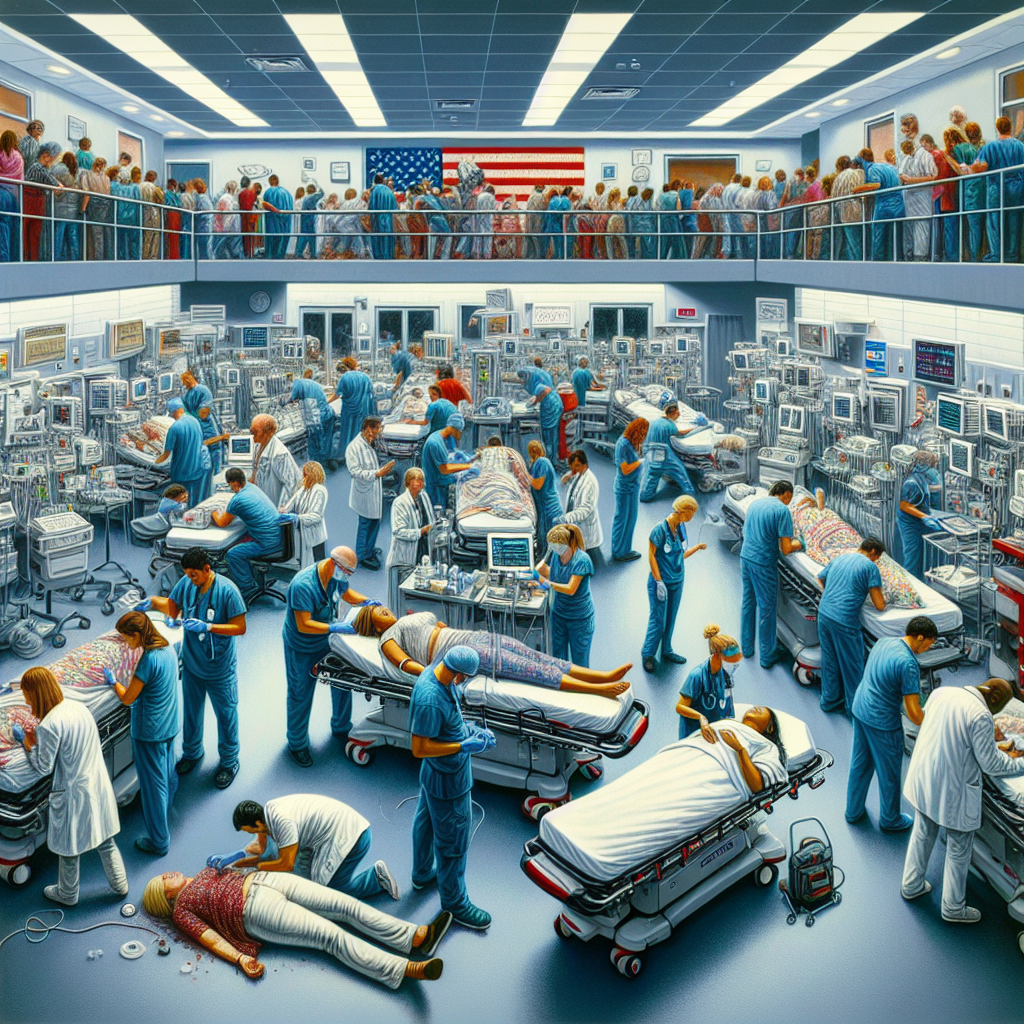Exploring America’s Busiest ER: Challenges and Triumphs in Emergency Care

Emergency rooms (ERs) are the frontline of healthcare, providing critical services to patients in need of immediate medical attention. In the United States, some ERs are busier than others, handling a staggering number of cases daily. This article delves into the complexities of America’s busiest ERs, examining the challenges they face and the triumphs they achieve in delivering emergency care. Through detailed analysis and real-world examples, we aim to provide a comprehensive understanding of the dynamics at play in these high-pressure environments.
The Landscape of Emergency Care in America
Emergency care in the United States is a vital component of the healthcare system, serving as a safety net for millions of Americans. ERs are tasked with providing immediate care for a wide range of medical conditions, from minor injuries to life-threatening emergencies. The demand for emergency services has been steadily increasing, driven by factors such as population growth, an aging population, and the prevalence of chronic diseases.
According to the Centers for Disease Control and Prevention (CDC), there were approximately 145.6 million visits to emergency departments in the United States in 2016. This number has only grown in recent years, placing immense pressure on ERs to deliver timely and effective care. The busiest ERs, often located in urban areas, face unique challenges in managing high patient volumes while maintaining quality care.
- High patient volumes
- Resource constraints
- Staffing challenges
- Complex patient needs
- Regulatory and financial pressures
These factors contribute to the complexity of emergency care delivery, requiring innovative solutions and dedicated healthcare professionals to navigate the challenges effectively.
Challenges Faced by America’s Busiest ERs
Operating at the intersection of high demand and limited resources, America’s busiest ERs encounter numerous challenges that impact their ability to provide optimal care. Understanding these challenges is crucial for developing strategies to improve emergency care delivery.
Overcrowding and Patient Flow
One of the most significant challenges faced by busy ERs is overcrowding. Overcrowding occurs when the demand for emergency services exceeds the available resources, leading to longer wait times and reduced quality of care. This issue is exacerbated by factors such as a shortage of inpatient beds, delays in patient discharge, and an increase in non-urgent visits to the ER.
To address overcrowding, many ERs have implemented strategies to improve patient flow, such as:
- Streamlining triage processes to prioritize patients based on the severity of their condition
- Utilizing fast-track systems for minor injuries and illnesses
- Implementing electronic health records (EHRs) to enhance communication and coordination among healthcare providers
- Collaborating with community healthcare providers to redirect non-emergency cases to appropriate care settings
Despite these efforts, overcrowding remains a persistent challenge, requiring ongoing innovation and collaboration to ensure timely access to emergency care.
Resource Constraints and Financial Pressures
Resource constraints are a common issue in busy ERs, impacting their ability to deliver high-quality care. Limited financial resources can lead to shortages of essential medical supplies, outdated equipment, and inadequate staffing levels. These constraints are often compounded by financial pressures, such as reimbursement challenges and uncompensated care costs.
To mitigate these challenges, ERs have adopted various strategies, including:
- Seeking alternative funding sources, such as grants and donations
- Implementing cost-saving measures, such as bulk purchasing and energy-efficient practices
- Advocating for policy changes to improve reimbursement rates and reduce uncompensated care burdens
While these strategies can alleviate some financial pressures, sustainable solutions require systemic changes at the policy level to ensure adequate funding and resources for emergency care.
Staffing Challenges and Burnout
The demanding nature of emergency care places significant stress on healthcare professionals, leading to staffing challenges and burnout. High patient volumes, long working hours, and the emotional toll of dealing with critical cases contribute to high turnover rates and staffing shortages in ERs.
To address these challenges, ERs have implemented measures to support their staff, such as:
- Offering competitive salaries and benefits to attract and retain skilled professionals
- Providing opportunities for professional development and career advancement
- Implementing wellness programs and mental health support services to address burnout
- Utilizing technology, such as telemedicine, to reduce the burden on staff and improve patient care
By prioritizing the well-being of their staff, ERs can create a more sustainable work environment and improve the quality of care provided to patients.
Complex Patient Needs and Coordination of Care
ERs often serve as the first point of contact for patients with complex medical needs, requiring coordination of care across multiple specialties and healthcare providers. This complexity can lead to challenges in ensuring continuity of care and preventing medical errors.
To address these challenges, ERs have adopted strategies to enhance care coordination, such as:
- Implementing integrated care models that facilitate communication and collaboration among healthcare providers
- Utilizing care coordinators to manage transitions of care and follow-up appointments
- Leveraging technology, such as EHRs and health information exchanges, to share patient information and improve decision-making
By improving care coordination, ERs can enhance patient outcomes and reduce the risk of medical errors, ultimately leading to better overall care.
Regulatory and Compliance Challenges
ERs operate within a complex regulatory environment, requiring compliance with numerous federal, state, and local regulations. These regulations are designed to ensure patient safety and quality of care but can also pose challenges for busy ERs.
To navigate these challenges, ERs have implemented strategies to ensure compliance, such as:
- Establishing dedicated compliance teams to monitor regulatory changes and implement necessary updates
- Providing ongoing training and education for staff on regulatory requirements and best practices
- Utilizing technology to streamline compliance processes and reduce administrative burdens
By prioritizing compliance, ERs can maintain high standards of care and avoid potential legal and financial repercussions.
Triumphs in Emergency Care: Innovations and Success Stories
Despite the challenges they face, America’s busiest ERs have achieved remarkable successes in delivering emergency care. Through innovation, collaboration, and dedication, these ERs have developed effective solutions to improve patient outcomes and enhance the quality of care.
Innovative Care Models and Best Practices
Many busy ERs have adopted innovative care models and best practices to address the challenges of emergency care delivery. These models focus on improving patient flow, enhancing care coordination, and optimizing resource utilization.
Examples of innovative care models include:
- The use of telemedicine to provide remote consultations and reduce the burden on ER staff
- The implementation of rapid assessment and treatment units to expedite care for high-acuity patients
- The development of specialized care pathways for common conditions, such as chest pain and stroke, to streamline diagnosis and treatment
By adopting these models, ERs can improve efficiency, reduce wait times, and enhance patient satisfaction.
Collaborative Partnerships and Community Engagement
Collaboration and community engagement are key components of successful emergency care delivery. Many busy ERs have established partnerships with local healthcare providers, community organizations, and government agencies to address the social determinants of health and improve access to care.
Examples of collaborative initiatives include:
- Partnering with primary care providers to establish referral networks and reduce non-urgent ER visits
- Collaborating with social services organizations to address housing, food insecurity, and other social needs
- Engaging with local government agencies to develop emergency preparedness plans and improve disaster response capabilities
Through these partnerships, ERs can enhance the overall health and well-being of their communities and reduce the demand for emergency services.
Advancements in Technology and Data Analytics
Technology and data analytics play a crucial role in modernizing emergency care delivery. Many busy ERs have leveraged technology to improve patient care, enhance operational efficiency, and support decision-making.
Examples of technological advancements include:
- The use of electronic health records (EHRs) to streamline documentation and improve communication among healthcare providers
- The implementation of predictive analytics to identify trends and optimize resource allocation
- The adoption of mobile health applications to engage patients in their care and provide real-time health information
By harnessing the power of technology, ERs can enhance the quality of care and improve patient outcomes.
Patient-Centered Care and Quality Improvement Initiatives
Patient-centered care is a core principle of emergency care delivery, focusing on meeting the needs and preferences of patients and their families. Many busy ERs have implemented quality improvement initiatives to enhance patient-centered care and improve the overall patient experience.
Examples of quality improvement initiatives include:
- The use of patient feedback surveys to identify areas for improvement and implement changes
- The development of patient education programs to empower patients to manage their health and make informed decisions
- The implementation of family-centered care models that involve family members in the care process and decision-making
By prioritizing patient-centered care, ERs can improve patient satisfaction and foster a culture of continuous improvement.
Success Stories and Case Studies
Many busy ERs have achieved remarkable success in overcoming challenges and delivering high-quality care. These success stories serve as valuable examples for other ERs seeking to improve their operations and patient outcomes.
Case studies of successful ERs include:
- An urban ER that reduced wait times by implementing a fast-track system for minor injuries and illnesses
- A rural ER that improved care coordination by establishing a telemedicine program to connect with specialists in larger hospitals
- A pediatric ER that enhanced patient satisfaction by creating a child-friendly environment and involving families in the care process
These success stories demonstrate the potential for innovation and collaboration to transform emergency care delivery and improve patient outcomes.
The Future of Emergency Care in America
The future of emergency care in America is shaped by ongoing challenges and opportunities for innovation. As the demand for emergency services continues to grow, ERs must adapt to changing healthcare needs and embrace new technologies and care models to deliver high-quality care.
Emerging Trends and Innovations
Several emerging trends and innovations are poised to transform emergency care delivery in the coming years. These trends include:
- The integration of artificial intelligence (AI) and machine learning to enhance decision-making and improve patient outcomes
- The expansion of telemedicine and remote monitoring to increase access to care and reduce the burden on ERs
- The development of personalized medicine approaches to tailor treatments to individual patients’ needs and preferences
By embracing these trends, ERs can enhance the quality of care and improve patient outcomes.
Policy and Regulatory Changes
Policy and regulatory changes play a crucial role in shaping the future of emergency care. Key areas for policy reform include:
- Improving reimbursement rates and reducing uncompensated care burdens to ensure adequate funding for ERs
- Enhancing access to primary care and preventive services to reduce the demand for emergency services
- Addressing social determinants of health to improve overall health outcomes and reduce healthcare disparities
By advocating for these changes, ERs can create a more sustainable and equitable healthcare system.
The Role of Healthcare Professionals
Healthcare professionals play a vital role in shaping the future of emergency care. By embracing innovation, collaboration, and continuous improvement, they can drive positive change and improve patient outcomes.
Key areas for professional development include:
- Enhancing clinical skills and knowledge through ongoing education and training
- Developing leadership and management skills to drive organizational change
- Engaging in research and quality improvement initiatives to advance the field of emergency care
By investing in their professional development, healthcare professionals can contribute to the advancement of emergency care and improve patient outcomes.
The Importance of Community Engagement
Community engagement is a critical component of successful emergency care delivery. By partnering with local organizations and stakeholders, ERs can address the social determinants of health and improve access to care.
Key strategies for community engagement include:
- Building partnerships with local healthcare providers to establish referral networks and reduce non-urgent ER visits
- Collaborating with social services organizations to address housing, food insecurity, and other social needs
- Engaging with local government agencies to develop emergency preparedness plans and improve disaster response capabilities
By prioritizing community engagement, ERs can enhance the overall health and well-being of their communities and reduce the demand for emergency services.
The Path Forward: A Vision for Emergency Care
The path forward for emergency care in America is shaped by a vision of innovation, collaboration, and continuous improvement. By embracing new technologies, care models, and policy changes, ERs can enhance the quality of care and improve patient outcomes.
Key components of this vision include:
- Leveraging technology to enhance decision-making and improve patient outcomes
- Implementing innovative care models to optimize resource utilization and improve patient flow
- Advocating for policy changes to ensure adequate funding and resources for emergency care
- Engaging with communities to address social determinants of health and improve access to care
By working together, healthcare professionals, policymakers, and communities can create a more sustainable and equitable healthcare system that meets the needs of all Americans.
Conclusion: Key Takeaways
America’s busiest ERs face numerous challenges in delivering emergency care, from overcrowding and resource constraints to staffing shortages and regulatory pressures. Despite these challenges, they have achieved remarkable successes through innovation, collaboration, and dedication.
Key takeaways from this exploration of America’s busiest ERs include:
- The importance of addressing overcrowding and improving patient flow to enhance access to care
- The need for sustainable funding and resources to support high-quality emergency care delivery
- The role of healthcare professionals in driving innovation and improving patient outcomes
- The significance of community engagement in addressing social determinants of health and reducing the demand for emergency services
- The potential for technology and data analytics to transform emergency care delivery
By embracing these insights and working together, healthcare professionals, policymakers, and communities can create a brighter future for emergency care in America, ensuring that all patients receive the timely and effective care they need.





